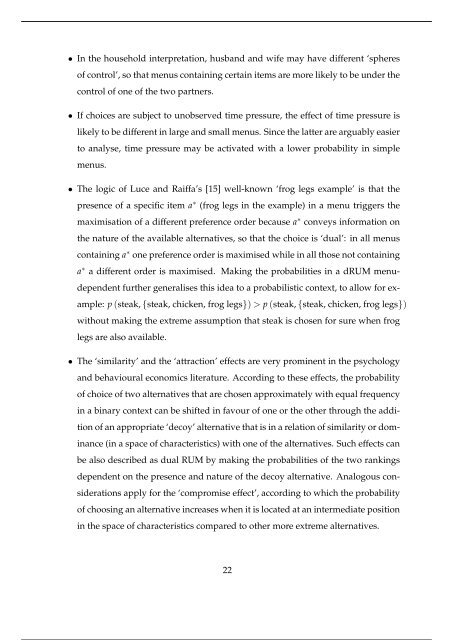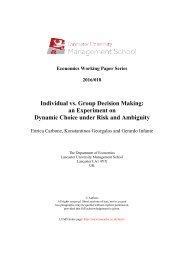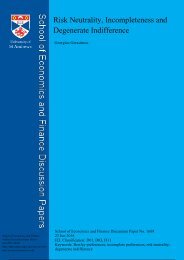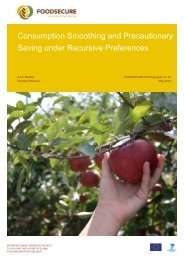Dual Random Utility Maximisation
n?u=RePEc:san:wpecon:1605&r=upt
n?u=RePEc:san:wpecon:1605&r=upt
You also want an ePaper? Increase the reach of your titles
YUMPU automatically turns print PDFs into web optimized ePapers that Google loves.
• In the household interpretation, husband and wife may have different ‘spheres<br />
of control’, so that menus containing certain items are more likely to be under the<br />
control of one of the two partners.<br />
• If choices are subject to unobserved time pressure, the effect of time pressure is<br />
likely to be different in large and small menus. Since the latter are arguably easier<br />
to analyse, time pressure may be activated with a lower probability in simple<br />
menus.<br />
• The logic of Luce and Raiffa’s [15] well-known ‘frog legs example’ is that the<br />
presence of a specific item a ∗ (frog legs in the example) in a menu triggers the<br />
maximisation of a different preference order because a ∗ conveys information on<br />
the nature of the available alternatives, so that the choice is ‘dual’: in all menus<br />
containing a ∗ one preference order is maximised while in all those not containing<br />
a ∗ a different order is maximised. Making the probabilities in a dRUM menudependent<br />
further generalises this idea to a probabilistic context, to allow for example:<br />
p (steak, {steak, chicken, frog legs}) > p (steak, {steak, chicken, frog legs})<br />
without making the extreme assumption that steak is chosen for sure when frog<br />
legs are also available.<br />
• The ‘similarity’ and the ‘attraction’ effects are very prominent in the psychology<br />
and behavioural economics literature. According to these effects, the probability<br />
of choice of two alternatives that are chosen approximately with equal frequency<br />
in a binary context can be shifted in favour of one or the other through the addition<br />
of an appropriate ‘decoy’ alternative that is in a relation of similarity or dominance<br />
(in a space of characteristics) with one of the alternatives. Such effects can<br />
be also described as dual RUM by making the probabilities of the two rankings<br />
dependent on the presence and nature of the decoy alternative. Analogous considerations<br />
apply for the ‘compromise effect’, according to which the probability<br />
of choosing an alternative increases when it is located at an intermediate position<br />
in the space of characteristics compared to other more extreme alternatives.<br />
22






